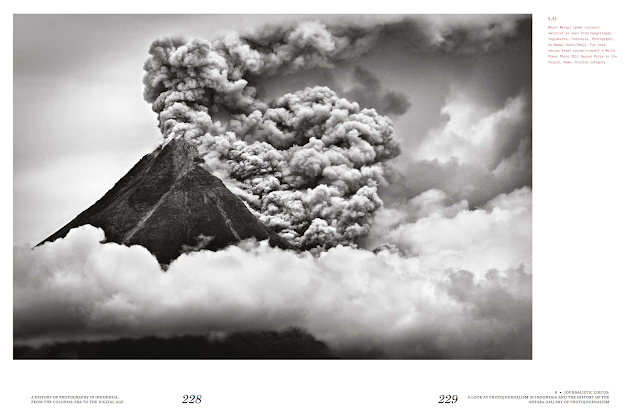 |
A History of Photography in Indonesia by Brian Arnold.
|
From the Colonial Era to the Digital Age
Edited by Brian Arnold
Amsterdam University Press, 2022. 496 pp., 9x11½x1¼".
It takes some gumption to tackle the photographic history of an entire country. That would be a tall order for any place, and when the nation is the fourth most populous in the world, comprised of 17,000 islands and studied from afar by a non-resident scholar, the task becomes daunting. This was roughly the chore self-assigned a decade ago by Brian C. Arnold, a photographer, teacher and all-purpose Indonesia-phile based in Ithaca, NY. His recently published A History of Photography in Indonesia is an ambitious undertaking. After years in the making, it weighs in at roughly five pounds and 500 pages. Upping the stakes, its publisher is based in The Netherlands, Indonesia’s former colonial ruler.
Arnold is an ardent gamelan musician, so his name may ring a bell. You might also recognize him as a regular contributor to photo-eye’s blog. But his book’s origin story precedes those activities. Arnold first visited Indonesia in the 1990s at the tender age of 22. He was immediately enamored, and it was around this time that he also became interested in fine art photography. Over the next few decades he fed both passions through a steady regiment of study, travel, practice and academic projects, and of course photo-making (you can see a sampling of his Indonesian photos in the book’s opening pages). These disparate interests kicked into high gear about a dozen years ago, as Arnold embarked on a series of longer trips to Indonesia, and began to network with other interested scholars. The present book might be viewed as a culmination of sorts, crystalizing his Indonesian and photo passions in one fell swoop.
 |
A History of Photography in Indonesia is roughly structured as a college textbook, surveying varied impressions of the titular archipelago. The title’s wording hints at Arnold’s wise decision to forgo dogma in favor of collaboration. Readers take note, this is merely “A” history, not “The” definitive one (although it is the first and only book on the subject to date). It’s modeled loosely as an academic symposium, with 18 essays by fourteen expert contributors including Arnold himself. Each has written in-depth on an Indonesian topic of their choosing, ranging from press photos to dance to Bandung, family albums and more. They’re sequenced by subject in chronological order, beginning in the 1840s near the invention of photography and continuing to the present with a chapter of contemporary street photos of Jakarta. Alas, the book omits Muhammad Fadli and Fatris MF’s Banda Journal, a high watermark of contemporary Indonesian photography, but one which unfortunately appeared after the publication deadline.
 |
 |
As the book’s subheading affirms, the book’s time period can be described as from “the Colonial Era to the Digital Age”. Those two forces — Colonialism and digital photography — stake out diametric poles in a continually evolving struggle between authoritarianism and democracy. It’s applied to Indonesia in this book but the symbolism might be extended just as easily to other countries and periods. Corporate and state powers have long viewed control of images as an extension of institutional control. The photo-making impulse, meanwhile, has traced a history of ever-broadening populism and self-representation. Early chapters in the book describe portraiture in the former Dutch East Indies and state control under Suharto. By the post-colonial period the focus has shifted to Reformasi, the MES 56 Photo collective, and the liberating accessibility of iPhone picture making.
It’s no great leap to connect Indonesia’s political history to tectonic shifts in photography. Tension between photography’s use for state control battles its democratic underpinnings. Which will win out? There’s no victor (at least yet) but a general trend seems clear: “The arc of the moral universe is long but it bends toward justice.” When M.L. King spoke those words he had broader social currents in mind, but he might have been describing the course of photo history, which has veered generally toward accessibility, informality and sharing. At this point, there’s no putting the photo genie back in the bottle. Cameras are universalized. Pictures can be made and viewed by anyone. Eventually the same might be said for democracy and liberalism. We shall see.
 |
Indonesia is a perfect test case for such thoughts, and A History Of Photography In Indonesia jumps easily among related topics, sometimes in great depth. It’s admittedly a selective view, not a comprehensive history. Nevertheless, the book might serve as the core syllabus backbone in a general course on the subject, with full notes, index and bibliography included, as with any academic text. The chapters are well-written and varied; most are liberally illustrated with photographs, all carefully captioned and credited. Packaged with thoughtful graphic design and stuffed with many amazing images, the initial temptation is to browse casually like a stack of photos. And for those who choose to dive in full-bore, there’s plenty of rhetorical meat, a steaming cup of Java’s worth.
Purchase Book
Read More Book Reviews
 |
 |
 |
Blake Andrews is a photographer based in Eugene, OR. He writes about photography at blakeandrews.blogspot.com.









